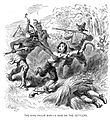Mary Rowlandson facts for kids
Mary Rowlandson (born White, later Talcott) lived from about 1637 to January 5, 1711. She was an American woman who lived in the colonies. In 1676, during a conflict called King Philip's War, she was captured by Native Americans. She was held for 11 weeks. After this time, she was bought back by her family.
Six years later, in 1682, Mary Rowlandson published a book about her experience. Its full title was The Sovereignty and Goodness of God: Being a Narrative of the Captivity and Restoration of Mrs. Mary Rowlandson. This book is very important in American history. It is one of the first and most famous examples of a "captivity narrative". These are stories written by people who were captured and later returned. Her book was so popular that it was printed four times in 1682. Many people read it in the New England colonies and in England. Some people even call it America's first "bestseller".
Contents
Mary Rowlandson's Early Life
Mary White was born around 1637 in Somerset, England. Her family moved from England to America before 1650. They first settled in Salem in the Massachusetts Bay Colony. In 1653, they moved to Lancaster. This town was on the edge of the settled areas.
In 1656, Mary married Joseph Rowlandson. He was a minister. They had four children between 1658 and 1669. Their first daughter died when she was very young.
Captured During King Philip's War
On February 10, 1676, at sunrise, Lancaster was attacked. This happened during King Philip's War. Narragansett, Wampanoag, and Nashaway/Nipmuc Native Americans led by Monoco attacked the town. Mary Rowlandson and her three children were among those captured. Their names were Joseph, Mary, and Sarah.
Mary's youngest daughter, Sarah, was six years old. She had been hurt during the attack. She died about a week later while they were being held captive.
Mary Rowlandson and her two other children were held for more than 11 weeks. They had to travel with the Native Americans through the wilderness. The Native Americans moved around to carry out other raids and to avoid the English soldiers.
Mary Rowlandson wrote about the difficult conditions of her captivity in her book. On May 2, 1676, she was bought back. The women of Boston raised £20 to pay for her release. John Hoar of Concord paid the money. This happened at Redemption Rock in Princeton, Massachusetts.
Life After Captivity
In 1677, Mary's husband, Reverend Rowlandson, moved his family to Wethersfield, Connecticut. He became a pastor there in April. He died in Wethersfield in November 1678. After his death, church leaders gave Mary a yearly payment of £30.
Mary Rowlandson and her children then moved to Boston. It is believed that she wrote her famous book there. The original handwritten copy of her book has not been found. Her book was published in Cambridge, Massachusetts, in 1682. It was also published in London that same year.
For a long time, some scholars thought Mary Rowlandson had died before her book was published. But it was later found that she lived for many more years. On August 6, 1679, she married Captain Samuel Talcott. She took his last name. Mary Rowlandson died on January 5, 1711. She was about 73 years old. She lived more than 18 years longer than her second husband.
Mary Rowlandson's Famous Book
Mary Rowlandson's book tells her own story. It describes being kidnapped and then bought back. It is a very important book in the "captivity narrative" style. In her book, she writes about seeing her family and friends killed. When she was captured, she traveled with her youngest child, Sarah. Sarah was only six years old and died during the journey. This happened near what is now Hardwick, Mass. Mary and her two other children were kept separate. They were treated like property until she was finally reunited with her husband after their ransom was paid.
Her strong Puritan faith helped her understand what she went through. Her book shows how her faith gave her strength and comfort. She often used quotes from the Bible in her story. These quotes helped her explain her experiences. They showed her belief that God's plan guides everything that happens. For example, when she didn't know where her children were, she wrote: "And my poor girl, I knew not where she was, not whether she was sick, or well, or alive, or dead. I repaired under these thoughts to my Bible (my great comfort in that time) and that scripture came to my hand, 'Cast thy burden on the Lord, and He shall sustain thee' (Psalm 55.22)."
People living in the colonies were very curious about her story. They wanted to know what it was like to live among Native Americans as a captive. Many English people already knew about other captivity stories. These were often written by traders or explorers who were captured at sea.
Mary Rowlandson's book is one of the most famous captivity narratives. It is often seen as a perfect example of this type of story. Her book is also interesting because it shows how different cultures met and interacted. It gives us a look into the mind and life of a Puritan person during that time.
See also
 In Spanish: Mary Rowlandson para niños
In Spanish: Mary Rowlandson para niños
- Captivity narrative
- Monoco, Nashaway sachem
- John Williams (New England minister), who wrote a captivity narrative after being captured in the 1704 Raid on Deerfield
Images for kids
-
Historical marker in Princeton, Massachusetts, commemorating Rowlandson's release









